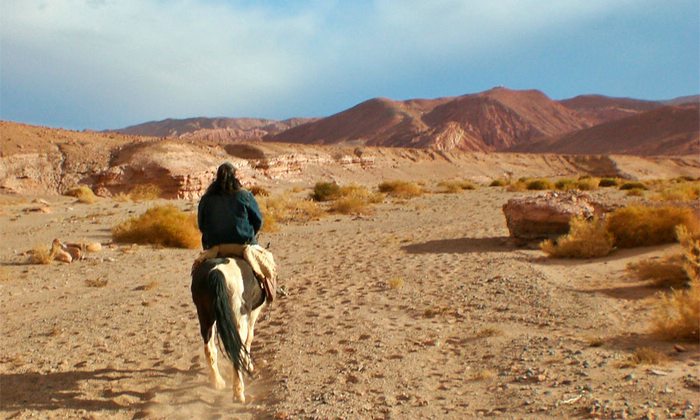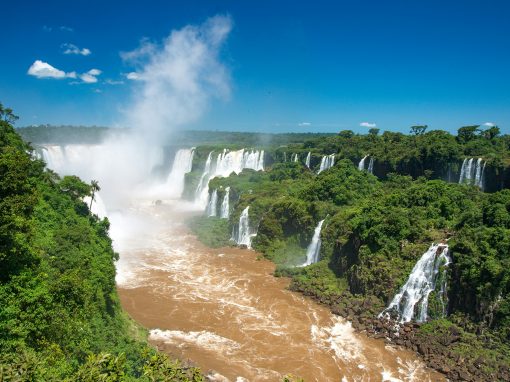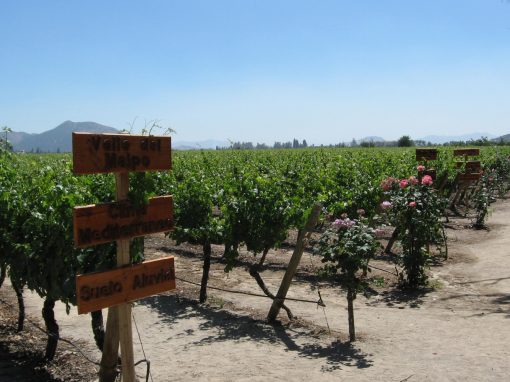Before joining Latin America For Less as a travel advisor, Kelly Hurst spent six months volunteering in Chile. During her time in South America’s narrowest country, she traveled to the northern region of Chile and shares the highlights of her adventure to the driest dessert of the world – the Atacama Desert.
Content
Gravitating to Atacama’s warmth
An early wake-up call for El Tatio
A four-legged tour through Moon Valley
Another tale from a cowgirl
The advice of an adventurist
Articles, videos, and more
Experience your own tour of northern Chile
Gravitating to Atacama’s warmth
In 2009, I traveled to the quaint Chilean mining town of Rancagua, located about an hour south of Santiago, to begin a six month volunteer program. While Rancagua and its people were lovely, a few fellow volunteers and I wanted to check out more of Chile.
It was winter in the southern hemisphere and we were ready for some warm weather. Instead of making our way south to Patagonia, we decided to follow the sun in the north. After enduring the cold and often rainy days in Chile’s central valley, a visit to San Pedro de Atacama, an oasis city of adobe buildings in the heart of the Atacama Desert, sounded perfect.
From Chile’s capital of Santiago, we took a direct flight to the coastal town of Iquique for a few relaxing days on the beach before continuing our trip by bus to San Pedro. After wandering the streets of San Pedro, we finally decided to take a tour to the local geysers of El Tatio.
An early wake-up call for El Tatio
The best time to visit El Tatio is between 6 and 7 am when the geysers are the most active. El Tatio is located at an altitude of 14,000 feet and our tour provider told us to dress in warm clothing because the temperatures plummet at night.
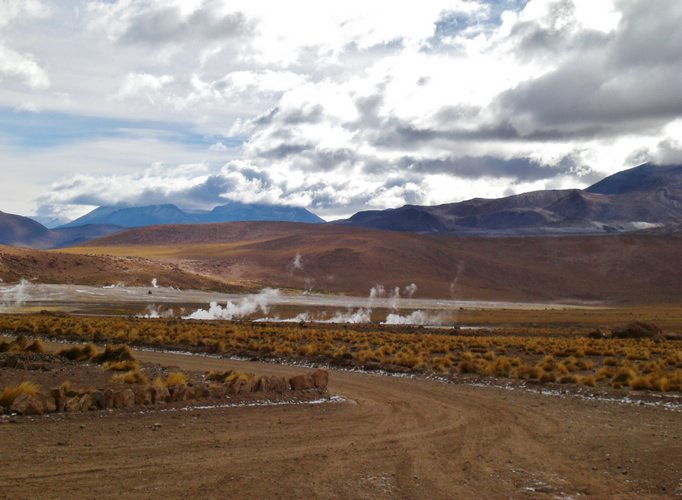 A morning look at El Tatio’s gurgling geysers.
A morning look at El Tatio’s gurgling geysers.
Photo By Kelly Hurst
I have to admit that I was not thrilled about the 2:45 am alarm, but our El Tatio tour operator had warned us that they would have no qualms about leaving us if we were not outside and ready by 3 am. Dressed in layers of warm clothes, we embarked on a bumpy ride from San Pedro through mountain roads to El Tatio. After checking in to the ranger station and paying the entry fee, the dawn began to break and we could see the first plumes of steam rising from the ridges above us.
We arrived to the Tatio geyser field just in time for one of the more unique breakfasts I’ve experienced; the guide actually boiled hot chocolate and water for coca tea inside one of the bubbling geysers!
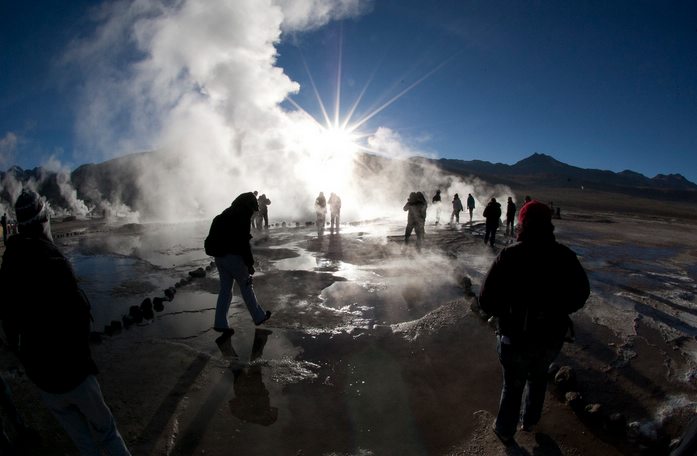 Thy geysers may be hot, but you’ll need to bundle up for your trip to El Tatio.
Thy geysers may be hot, but you’ll need to bundle up for your trip to El Tatio.
Photo by Dennis Fidalgo/Flickr
While waiting for some hot tea, I walked around the surreal landscapes, heeding the warnings about staying away from the geysers. Although it was extremely cold, the landscapes were absolutely stunning. Some of the braver members of our tour enjoyed the hot springs -though not the exit back into the freezing air. Our tour continued on through the mountains, past vicunas and alpacas, and arrived back in San Pedro in time for lunch.
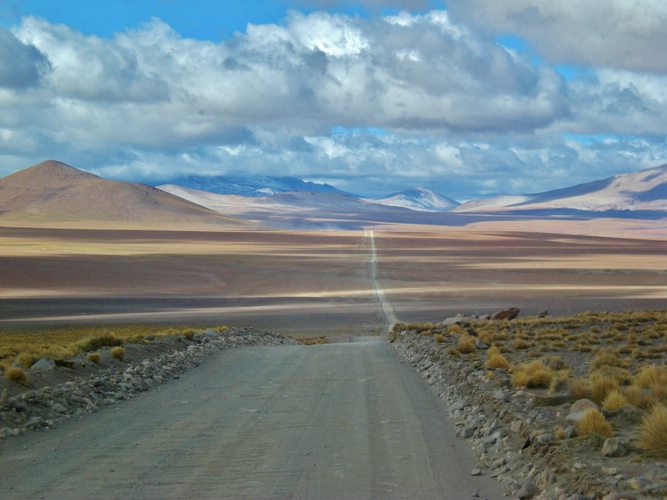 A memorable view back to San Pedro de Atacama.
A memorable view back to San Pedro de Atacama.
Photo by Kelly Hurst
A four-legged tour through Moon Valley
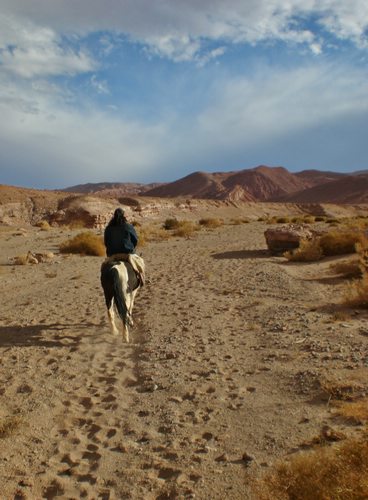 As a life-long horse enthusiast, I made a mental note of a small ranch that offered horseback riding while wandering though the streets of San Pedro. Later that day my friends took a nap and I returned to the small ranch for an afternoon ride.
As a life-long horse enthusiast, I made a mental note of a small ranch that offered horseback riding while wandering though the streets of San Pedro. Later that day my friends took a nap and I returned to the small ranch for an afternoon ride.
My guide and I rode to the edge of town and took a detour down a path into a small valley. The guide caught me off guard and burst into a full-out gallop and I just hung on for the ride. By the time we slowed down I had lost both of my stirrups, but was grinning from ear to ear. I was glad that I had opted for the horses over the van tour – this was going to be fun!
Over the next several hours we rode across the bleak white, but enchanting desert scenery of Valle de la Luna, or Valley of the Moon. The rugged mix of orange, gold, and white desert colors contrasted beautifully with the dark blue sky.
We stopped to observe the ruins of Pukará de Quitor that were left by the natives of the Atacama. After viewing the ancient ruins, we crossed a shallow river and started to head back to San Pedro. I smiled as we met several bikers struggling with the high altitude and the heat. Unfortunately, they were painfully forced to backtrack several miles to a bridge because they were unable to cross the river on their bikes. Gracias, caballos! (Thank you, horses!)
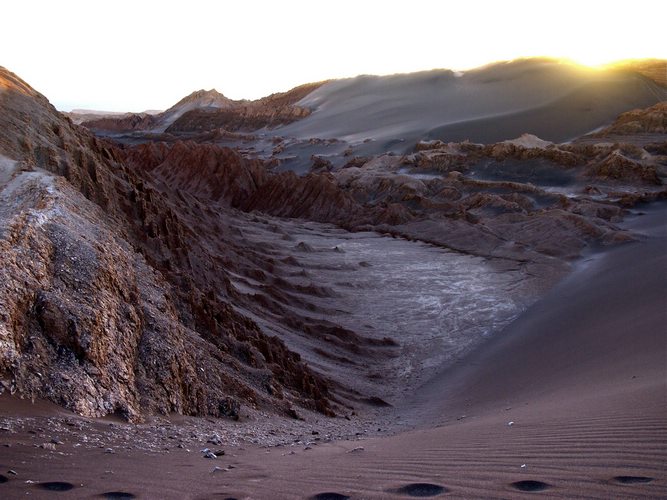 The moon-like terrain of Valle de la Luna.
The moon-like terrain of Valle de la Luna.
Photo by Shaun Dunphy/Flickr
Another tale from a cowgirl
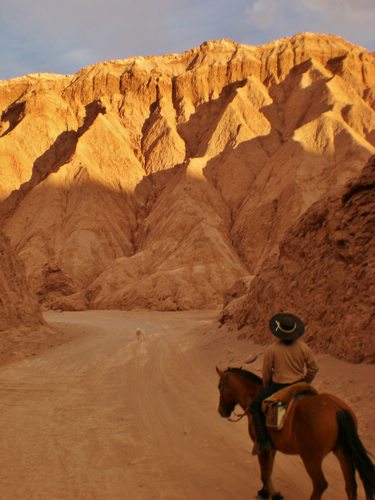 I had talked so much about my first ride that I convinced my friend, Kate, to come along for another adventure on horseback. After much deliberation, we decided on a ride to the must-see Valle de la Muerte, or Death Valley. We mounted around 2 pm, and Kate -a first time rider who took the “Death Valley” name literally- said her goodbyes to our other friends.
I had talked so much about my first ride that I convinced my friend, Kate, to come along for another adventure on horseback. After much deliberation, we decided on a ride to the must-see Valle de la Muerte, or Death Valley. We mounted around 2 pm, and Kate -a first time rider who took the “Death Valley” name literally- said her goodbyes to our other friends.
As we rode deeper into the desert valley, the landscape colors transitioned from dusty grays and yellows into fiery oranges. The ride began on sandy rocks, but we soon traversed on horseback across a terrain of pure sand surrounded by jagged peaks.
Our guide pointed to a dauntingly steep sand dune decorated with old hoof prints. He commented that sometimes the advanced riders would climb up the dune and then slide down it. It sounded like fun, but I was content just enjoying the gorgeous scenery. I had already “horse skied” down several steep Colorado hills, and since I grew up riding around a flat arena in the United States, steep descents are one of the 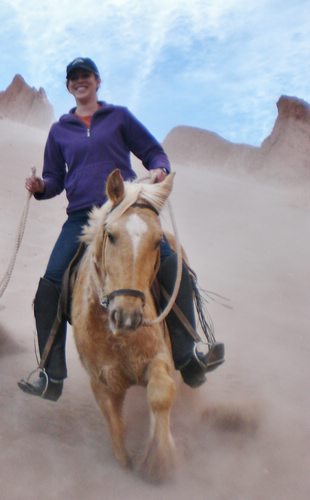 only things that make me nervous on horseback.
only things that make me nervous on horseback.
We let the horses slowly fight up the dune, exerting a great amount of effort to reach the top. My friend Kate and I felt sorry for them; we could relate after sandboarding in Iquique and having to climb back up a tiny dune each time. It was great fun, but exhausting!
From the top of the sand dunes, the return path looked like it was almost straight down. After grabbing my camera, the guide smiled, leaned back, and started his run and told us to come along! Kate was hyperventilating, and I wasn’t sure how to reassure her because I was a bit nervous myself, but going down was the only way out of this. The horses merely sat back on their haunches and shuffled their legs, sliding gracefully through the thick sand. After the initial nervousness passed, it was fantastic! The experience was an adrenaline rush, and by the time we made it to the bottom even poor shaking Kate admitted that it was cool.
At the bottom of the sand dune I got the okay from my guide to take off on a canter across the sand. It was pure bliss being alone in the desert with just my horse and the dog that came along for the ride. After the others caught up with me, we all rode back to San Pedro as the sun was setting. Kate was glad she had survived and was grateful that she had gone with me on this nerve-wracking, but uniquely experience. I was in sheer horse heaven.
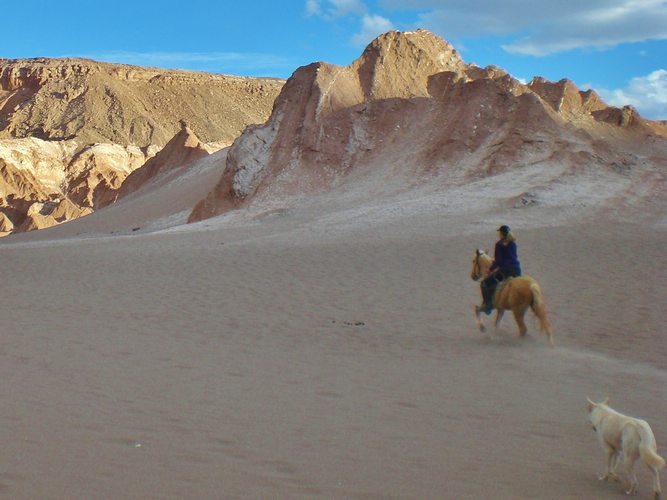 Enjoying one last ride across the Atacama Desert, an experience Kelly describes as “pure bliss”.
Enjoying one last ride across the Atacama Desert, an experience Kelly describes as “pure bliss”.
Photo by Kelly Hurst
The advice of an adventurist
When planning a trip to the geysers of El Tatio…
- Don’t forget to set your alarm. It’s an early wake-up call!
- Dress in warm layers and, if possible, bring gloves and a warm hat.
- If you plan on dipping in the hot springs, don’t forget your swim suit and towel.
- Make sure your camera is charged.
Articles, videos, and more
Other websites and articles:
Video tour of geysers at El Tatio: http://www.youtube.com/watch?v=IcsULvZpA3E
Ruins of Pukara de Quitor: http://www.jeroenvanboxtel.com/travel/chile/en/chile-17july-PukaraDeQuitor.html
Photos:
Photo essay: ‘San Pedro de Atacama’: http://www.digitaljournal.com/article/356218
Videos:
Atacama Desert: Valle de la Luna: http://www.youtube.com/watch?v=91sKc2vY04Y
El Tatio: http://www.youtube.com/watch?v=IcsULvZpA3E
Experience your own tour of northern Chile
Contact our team of travel experts to customize a trip of your own to a South American desert!

Latin America for Less is a group of travel experts who live, work, eat, and breathe all things South America. Their inspiration stems from a deep appreciation for the beauty and diversity that make this continent so special.

